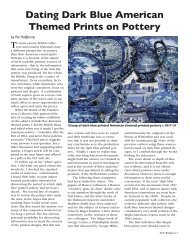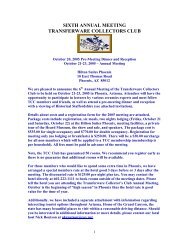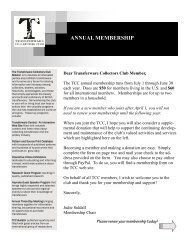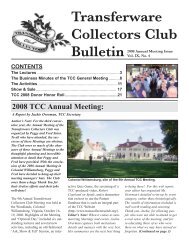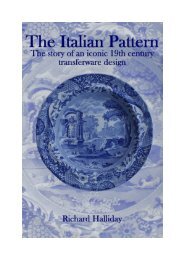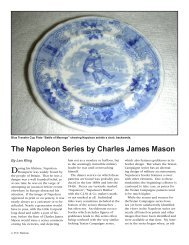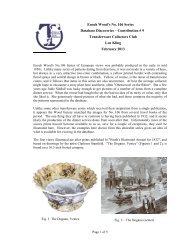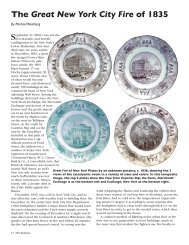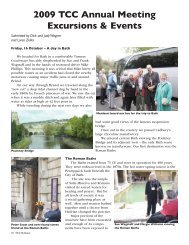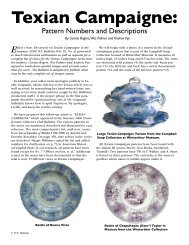download the publication - Transferware Collectors Club
download the publication - Transferware Collectors Club
download the publication - Transferware Collectors Club
Create successful ePaper yourself
Turn your PDF publications into a flip-book with our unique Google optimized e-Paper software.
1792” when he published a series of local views when he was at Swansea’<br />
Grant-Davidson believed that Rothwell would have trained apprentices<br />
and it is likely <strong>the</strong>re may have been engravers working for such a large<br />
pottery as Swansea before Rothwell’s arrival. What is apparent with<br />
regards to large dinner service pieces such as <strong>the</strong> ‘Longbridge’ patterned<br />
ones is that Rothwell could not have engraved all <strong>the</strong> shapes and sizes of<br />
engravings required; it is much more probable that he engraved a few of<br />
<strong>the</strong> larger coppers to set as templates and also to set his own engraving<br />
style to be copied by o<strong>the</strong>rs employed by <strong>the</strong> Cambrian; Rothwell’s<br />
apprentices would, of course, have been trained in his ‘style’ of engraving.<br />
Some experts refer to <strong>the</strong> transfer printing style of a pottery’s output, and<br />
this would have applied not just to Swansea but to o<strong>the</strong>r potteries also. It<br />
seems a style was set by leader engravers and o<strong>the</strong>rs were instructed to<br />
follow—much as a master painter in his studio set <strong>the</strong> style that his<br />
students followed even on occasions finishing off parts of <strong>the</strong> painting left<br />
incomplete by <strong>the</strong> master himself.<br />
Rothwell’s plates would have been used over and over with a very large<br />
number of pulls taken from each copper. Even when <strong>the</strong> plate showed<br />
wear it would be reworked and used again and again to its ultimate<br />
demise. These coppers were extremely expensive to create and it was<br />
<strong>the</strong>refore essential to put <strong>the</strong>m to full use especially <strong>the</strong> ‘Rothwell’ master<br />
examples. It should be remembered <strong>the</strong> expense involved in producing a<br />
copper plate. As E. Stanley Price states in ‘John Saddler: A Liverpool<br />
Pottery Printer’:<br />
“Upon <strong>the</strong>ir skill <strong>the</strong> success of <strong>the</strong> entire operations depended …….Their<br />
fees were high, for a set of jugs probably two quart, three pint, quart, pint<br />
and half pint <strong>the</strong> charge was £30.00.” The cost was high because as Price<br />
says:<br />
“It took at least five days to engrave a single portrait.”<br />
Of course with a more complicated and larger pattern <strong>the</strong> time taken would<br />
have been much longer. E. Stanley Price comments fur<strong>the</strong>r that in <strong>the</strong><br />
eighteenth century:<br />
“The plates were etched first and touched with <strong>the</strong> graver and “bitten” with<br />
Aqua Regia.”<br />
Athough acid etching continues to this day copper plate engravings in <strong>the</strong><br />
late 18th and early 19 th century were soon being done by <strong>the</strong> ‘hand push’<br />
7



